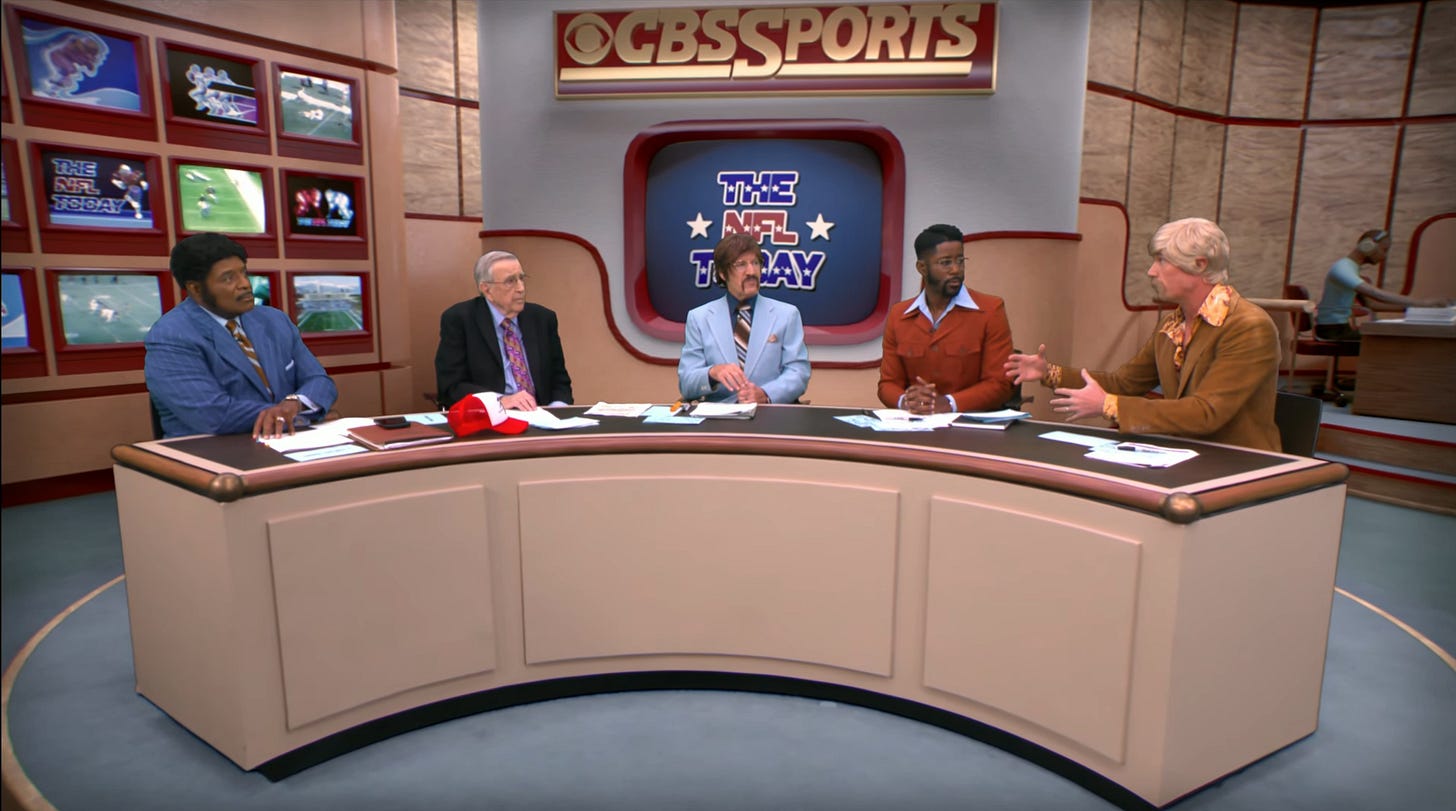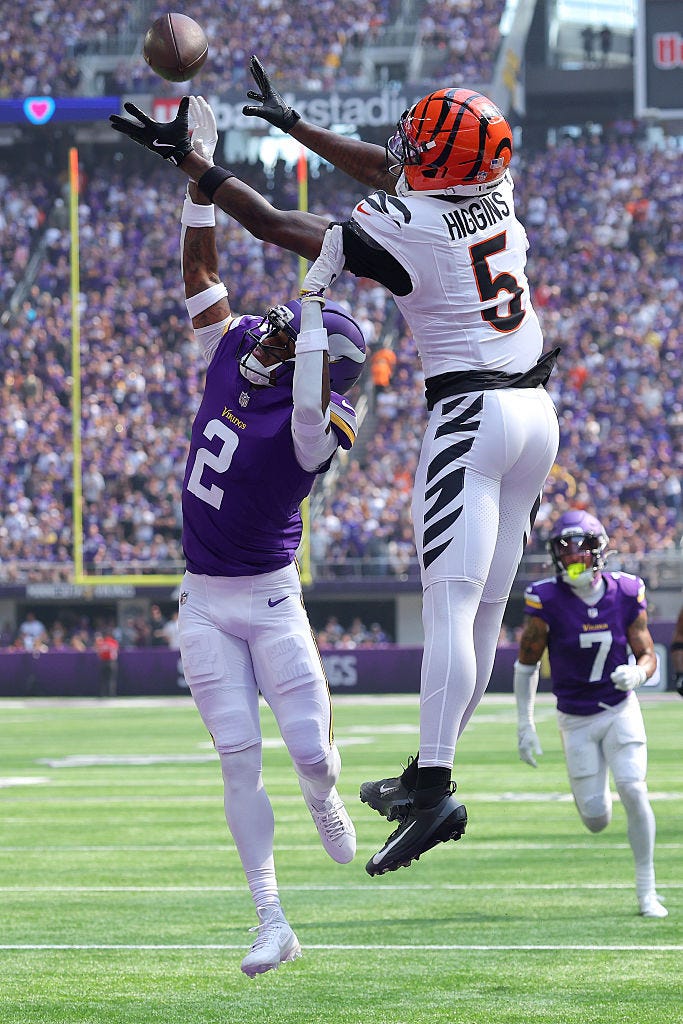The Minnesota Vikings Signed the Right Rodgers: 48-10 Win Over Cincinnati Bengals
The Minnesota Vikings paid homage to the retro-themed CBS broadcast with a throwback beatdown. Let's talk about it.
History haunted the Cincinnati Bengals in their loss to the Minnesota Vikings before the game had even started.
CBS Sports, which televised the Bengals-Vikings game, began the pregame festivities with a throwback broadcast, complete with digitally reconstructed sets from their 1970s broadcasts and costumes for all their personalities.
The Vikings’ win over the Bengals seemed to carry the hallmarks of that older style of play, one marked by defensive scoring and an emphasis on a running game led by a between-the-tackles, pounding runner.
The Vikings have an astoundingly rich tradition of backup quarterbacks coming in to lead the team to unlikely victories – whether that’s the more well-recognized Case Keenum, the less-remembered Gus Frerotte and the surprising reminder of Randall Cunningham’s backup status before his historic 1998 campaign.
Critically, all of these backups performed up to those historic levels not by playing safe football, the caretaker style so favored by many coaches when it comes to their backups, but instead aggressive and risky football. They held on to the ball, launched deep balls and took incredible chances that happened to pay off.
In some ways, Wentz seemed perfectly suited for this legacy of play. He waits for explosives to develop and then rifles the ball deep for big plays – in many ways the playing style embodied by Keenum and Cunningham. And, unlike Keenum, he has the arm strength to give lift to those throws.
It’s hard to ignore the comparison. In 2017, Vikings were ready for their promising, injury-riddled acquisition, Sam Bradford, to take over after a full offseason with the offense. Instead, a backup with barely any time with the first team was thrust into the spotlight. It looked pretty dire.
Then, in Week 3, the Vikings defense forced three interceptions and two fumbles en route to a beatdown. That time, it was of Jameis Winston’s Tampa Bay Buccaneers. This time, it was Jake Browning’s Cincinnati Bengals.
It’s not a perfect comparison, of course. Keenum had already played for the Vikings that year, and the Vikings didn’t actually recover the two fumbles from that Buccaneers game. But the specter of the past nevertheless haunted this game.
The broad strokes remain the same – Wentz, with under 200 yards passing, could hardly consider himself the driver of the Vikings win. It was instead the prodigious Vikings defense, led by low-cost cornerback acquisition Isaiah Rodgers, that produced the incredible result Minnesota put together – at one point, a 45-point lead.
Isaiah Rodgers’ Neighborhood
Since the year 2000, only three players have scored two defensive touchdowns in the first half of an NFL game. Antonio Cromartie accomplished this feat in 2007 against the Houston Texans, though one came on a fumbled punt snap. Another one occurred in 2017 – Eddie Jackson did so for the Chicago Bears against the Carolina Panthers. Again, a fumbled snap – this time on offense – led to one of the two scores.
Vikings fans just witnessed the third such event. Isaiah Rodgers, who returned an interception for a touchdown and a fumble for a touchdown, exceeded both those players in total defensive return yards on his scores with 153.
It was the first time it had happened in Vikings history – despite their long history of defensive success and, in particular, defensive scoring.
It seems as if, with the Vikings reportedly contemplating signing Aaron Rodgers in free agency this offseason, they made the correct decision about which Rodgers to add to their team.
Isaiah Rodgers’ first score came after Harrison Smith, in his first game back after an unspecified illness kept him out of training camp and two weeks of games, tipped the pass following a Levi Drake Rodriguez pressure. This careening ball landed into Rodgers’ hands, and he returned the ball 87 yards for a touchdown.
The second came on an unbelievable fumble and fumble recovery; Bengals backup quarterback – in the game due to a season-ending turf-toe injury to Joe Burrow – Jake Browning threw short to tight end Noah Fant. He advanced the ball four yards before Rodgers knocked the ball out using the “Peanut Punch” technique popularized (and named for) former Bears cornerback Charles “Peanut” Tillman.
Tillman, despite his mind-boggling career 44 forced fumbles, has only ever returned one fumble for a touchdown. It was a 40-yard scoop-and-score forced not by Tillman, but Urlacher. His fumble recovery touchdown sparked a comeback so meteoric that it has its own Wikipedia page. It was the cause of coach Denny Green’s iconic “They are what we thought they were” rant.
Rodgers wasn’t sparking a comeback so much as a beatdown. And on this play, he did it by himself.
Rodgers would force another fumble and generate another pass deflection as the game went on, and earned a preliminary 99.9 PFF grade for the game.
He wasn’t alone, though.
Vikings Defense Comes Through
Rodgers was one component of a stellar defensive unit that took advantage of the backup quarterback situation the Bengals were forced into. At minus-0.64 EPA per play and minus-33.32 total EPA, Cincinnati put together its worst offensive performance of the season.






